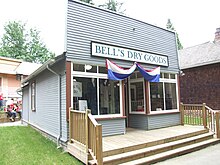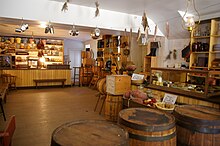Dry goods


Dry goods is a historic term describing the type of product line a store carries, which differs by region. The term comes from the textile trade, and the shops appear to have spread with the mercantile trade across the
The term goes back to the 17th century and originally referred to any goods measured in dry measure, not liquid measure, of volume, such as stere, bushel or peck. Dry goods as a term for textiles dates back to 1742 in England[1] or even a century earlier.[2]
Commonwealth and Philippines usage

In
U.S. usage

In the

Dry goods can be carried by stores specializing only in those products (a type of specialty store), or may be carried by a general store or a department store.[6]
‘Dry goods’ is the collective name of textile fabrics and manufactured articles.[1] In the late 1800s there were hundreds and thousands of dry goods wholesaling stores and retail stores in America throughout towns and villages, engaging over one million people into the industry of dry goods trades.[1]
Beginning in the early 20th century, many dry goods stores expanded into other lines of merchandise, and the term largely disappeared from both everyday usage and the official names of the businesses concerned. As an example, The Denver Dry Goods Company became known to a generation simply as The Denver, a mall anchor store in the western United States.[7]
See also
References
- ^ a b c d e Cole, George S. (1892). "Dry Goods". A Complete Dictionary of Dry Goods. Chicago: W. B. Conkey Company. 19th-century book about fabrics.
- ^ a b "dry goods". Merriam-Webster. Retrieved July 21, 2020.
- ^ "dry goods Meaning". dictionary.cambridge.org.
- ^ Dry Goods Economist. J. Mackey. 1917.
- ^ Dry goods Historical Marker data base.
- ^ "Retail middlemen of consumer goods". marketing-howto.com. Archived from the original on 2008-09-24.
- ^ ""The Elegant Things Have Vanished": Dining at The Denver Dry Goods' Tearoom | History Colorado". www.historycolorado.org. 1 Oct 2015. Archived from the original on 8 May 2021. Retrieved 8 May 2021.
In 1966, the Denver trimmed the Dry Goods from its name for the sake of keeping up with the pace of the go-go decade. Known as "The Denver," management added stores along the Front Range and in Montana over the next decade.
External links
 Media related to Dry goods at Wikimedia Commons
Media related to Dry goods at Wikimedia Commons
